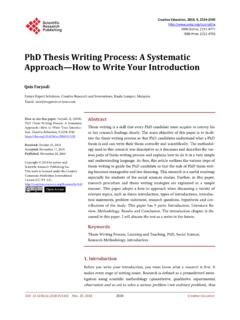Transcription of CHAPTER 3 METHODOLOGY 3.1 Introduction
1 36 CHAPTER 3 METHODOLOGY Introduction Research can be defined as the systematic process of collecting and logically analysing data for a given purpose (McMillan & Schumacher, 2010). However, this definition is generalised to some degree, since many methods are used to investigate a problem or question. Research methods (constituting a research METHODOLOGY ) are the ways in which one collects and analyses data. These methods have been developed for acquiring knowledge reliably and validly. A research METHODOLOGY is systematic and purposeful, planned to yield data on a particular research problem (McMillan & Schumacher, 2010). This CHAPTER aims to introduce and explain the rationale for the research methods chosen for the study. The CHAPTER begins by restating the research problem, provides a philosophical positioning of qualitative research and a description of research design.
2 As I have chosen a qualitative, case study approach for this study, these concepts are described in detail. Further to this, this CHAPTER identifies and describes the population, sample, research instruments and methods of data collection utilised in the study. This CHAPTER also provides a description of how the data will be analysed, and discusses the issue of reliability and validity as it pertains to the study. The CHAPTER concludes with a summary of the CHAPTER . Research problem With the Introduction of the new education system in South Africa, traditional approaches to school leadership are being challenged. Hierarchical, top-down approaches are being set aside for a more democratic, distributed form of leadership. In particular, there is a call for teachers to take on positions of leadership in the school. Teacher leadership is, however, a relatively new concept to the South African education system.
3 While the Government Gazette for the Norms 37 and Standards for Educators (2000) calls for teachers to take up leadership positions within and beyond their classrooms there is no mention of how this should be done. Studies conducted in South Africa focused on teachers understanding of the concept, and their readiness for teacher leadership (De Villiers and Pretorius, 2011). Other studies by Grant (2006, 2008) Singh (2007) and Khumalo and Grant (paper in progress) have investigated the enactment of teacher leadership, and barriers to teacher leadership. The purpose of this study was to investigate the way in which teacher leadership is developed in schools. The study also aimed to investigate teachers and SMTs understanding of the concept of teacher leadership. The reason for this is twofold, where: (1) teachers understanding of the concept could impact on their uptake of teacher leadership roles; and (2) the SMTs understanding of the concept has a direct and significant effect on whether teacher leadership is actually developed in a school.
4 This study also investigated the barriers that hinder teacher leadership. The study further investigated the way in which teacher leadership programmes are developed, implemented and evaluated. Positivism and interpretivism It is important to philosophically position qualitative research among other forms of research. Such a positioning entails what one believes about the nature of reality (ontology), and the nature of knowledge (epistemology) (Merriam, 2009). Traditional research paradigms make certain assumptions about the world. They assume that there is an objective reality that researchers ought to try and uncover as they conduct their research. Further, it is also assumed that that the role of the researcher is neutral, and that the main purpose is to discover the objective reality. These are referred to as positivist paradigms. A positivist orientation assumes that reality exists out there and that it is observable, stable and measureable (Merriam, 2009).
5 However, it became evident that capturing a reality that was out there was difficult, if not impossible, to achieve. This lead to a postpositivist point of view, which held that researchers should strive to capture reality using multiple methods. In such a way, reality might be approximated (Lichtman, 2006). 38 In contrast to the positivist approach, interpretive research, where qualitative research is most often located, assumes that reality is socially constructed, that is, that there is no single, observable reality (Merriam, 2009). Rather, there are multiple realities or interpretations of a single event. According to the tenets of this paradigm, researchers do not find knowledge, they construct it. Multiple realities, as constructed by the researcher, replaced the traditional single approximation of an objective reality (Lichtman, 2006). Constructivism is a term used interchangeably with interpretivism.
6 Constructivists claim that truth is relative and that it is dependent on one s perspective. This paradigm recognises the importance of the subjective human creation of meaning, but doesn t reject objectivity per se Miller and Crabtree (1999) cited in Merriam (2009). The choice of a case study approach used here is based on the constructivist paradigm. Research design Quantitative research designs emphasise objectivity in measuring and describing phenomena (McMillan & Schumacher, 2010). As such, the research design maximises objectivity by using numbers, statistics, structure and control. An important sub-classification of quantitative design is experimental and non-experimental. The difference between the two has significant implications for the nature of the design, and the types of conclusions that can be drawn. Qualitative research designs, however, use methods that are distinct from those used in quantitative designs.
7 While qualitative designs can be said to be just as systematic as quantitative designs, they emphasise gathering data on naturally occurring phenomena. Most data gathered is in the form of words and the researcher must search and explore with a variety of methods, until a deep understanding is achieved. Qualitative research designs can be organised by: (1) focus on individual lived experience, as seen in phenomenology, case study grounded theory and some critical studies; and (2) a focus on society and culture, as defined by ethnography and some critical studies (McMillan & Schumacher, 2011). For the purpose of my study I have chosen to use a qualitative research design. 39 Qualitative research Qualitative research is characterised by strategies that take the subject s perspective as central. This approach also pays significant attention to detailed observation in an attempt to produce a rich and deep description (Morrison, 2002).
8 In qualitative research, detailed consideration is given to the holistic picture in which the research topic is embedded. The underlying idea is that researchers can only make sense of the data collected if they are able to understand the data in a broader educational, social and historical context (Morrison, 2002). Qualitative research defies a simple definition (Merriam, 2009). There is also much confusion over what constitutes qualitative research. One of the problems in doing this is that qualitative research is often described by what it is not, namely, research that is not quantitative (Best & Kahn, 2006; Lichtman, 2006). This is a problem for two reasons: (1) some qualitative research results in some quantification; and (2) it represents a negative connotation that qualitative research is only what quantitative research isn t, rather than positively stating what it is (Best & Kahn, 2006).
9 Unlike quantitative research designs, qualitative research designs can vary significantly, depending on the theoretical framework, philosophy, assumptions about the nature of knowledge and the field of study (McMillan & Schumacher, 2011), resulting in different definitions of what constitutes qualitative research. Definitions of qualitative research Creswell (2007) describes qualitative research as research that begins with assumptions, a worldview, the possible use of a theoretical lens and the study of research problems inquiring into the meaning individuals or groups ascribe to a social or human problem. This definition stresses the importance of assumptions and the worldviews that provide the basis of the design. Lincoln and Guba (1985), cited in (Merriam, 2009), refer to this type of research as naturalistic inquiry , which implies that participant observational techniques result in a more natural approach than do those tests and surveys used in the more traditional quantitative approaches.
10 40 Marshall and Rossman (1999) suggest that qualitative research offers opportunities for conducting exploratory and descriptive research that uses the context and setting to search for a deeper understanding of the person(s) being studied. Qualitative research is a way of knowing that assumes that researcher gathers, organises and interprets information (usually in words or in pictures), using his or her eyes and ears as filters. It is a way of doing that often involves in- depth interviews and/or observations of humans in natural and social settings (Lichtman, 2006). Basically, qualitative researchers are interested in understanding the meaning people have constructed, that is, how people make sense of their world and the experiences they have in the world (Merriam, 2009). Characteristics of qualitative research Another strategy, to understand the complexity of qualitative research, is to determine its fundamental characteristics.







